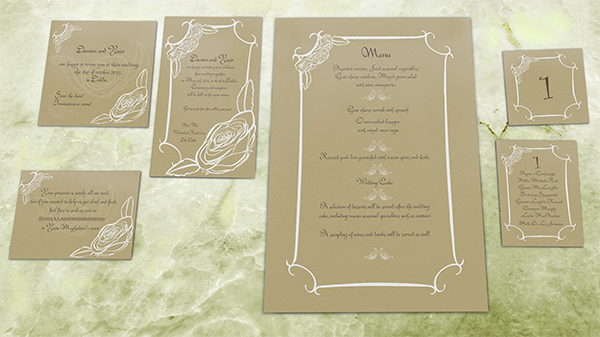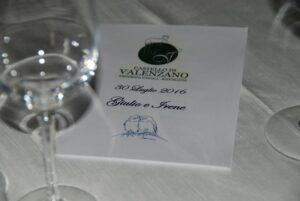The hows and whys of a wedding stationery suite
Or, the ramble of a stationery designer
Have you heard the term wedding stationery, but you’re confused about what it actually entails?
I was too at the beginning of my collaboration with Magical Vows: Costanza came to me asking if I could do a price  estimate for an invitation design for a wedding stationery suite, and I was caught unaware, and then fell down a very deep, months-long rabbit hole of research.
estimate for an invitation design for a wedding stationery suite, and I was caught unaware, and then fell down a very deep, months-long rabbit hole of research.
What is it, what is in it, how to do it, why is it needed?
Well, I’m Valentina from Nepturnal.art and I’m here to hopefully answer these questions for you, and save you the tumble down to the wonderland of wedding stationery design – unless you do want to tumble down that way, in which case I will gladly send you off a with a better understanding and a pack of biscuits for the way.
So, let’s just get the first and most important question out: wedding stationery is anything that belongs to your wedding that can be printed on card-stock or paper, usually, but not limited to just that.
This has lately changed to include some purely digital products, such as save the date or invitation designs that can be simply sent by e-mail or WhatsApp even, or change the date designs, that have become very needed in this 2020 of pandemic pandemonium (try to say it three times fast if you can, I challenge you).
What’s in it?

I realize that this answer is actually quite vague, so let me give you a recap of the most common items in a wedding stationery suite, and their purpose.
Your guests will receive first the save the date design, which usually has the most basic information on it, such as your names, the date of the wedding, and the city you intend to get wed in.
This is useful for a few reasons, like giving guests that might live far away the time to book their flight or rooms, or give you a closer initial estimate of the number of guests you will actually have to contend with, so as to choose the most well-suited venue, or catering service.
It’s useful, but not always needed and certainly not traditional or mandatory.
The next thing that your future guests will see is the invitation: traditionally sent by snail-mail, but as I already said it can be done digitally too (or both, why not?), it lists the same information as the save the date, but in more detail, giving actual addresses for the ceremony and reception venue, should they be separate, as well as dress code and other minutiae like that, if needed. It is a part of the traditional wedding stationery suite, though in a very traditionally etiquette-driven wedding it will usually state that the parents of the spouses are the ones inviting the guests.
Speaking of etiquette, the invitation is often accompanied by a card, note or ticket, where the spouses can direct the guests towards a specific list for their gifts, or to a banking account or physical address to leave money instead.
This is something that the true, formal, wedding will never do, but is becoming the norm in most other circumstances (you don’t want to receive three of the same blender, right? Or hundreds of plates and no bed coverlets).
 Menus, place cards, escort cards, table name cards and table plans
Menus, place cards, escort cards, table name cards and table plans
These are what comes next, directly at the venue. They are the most self-explanatory part of the wedding stationery suite: a Menu has the courses and dishes of your meal described, and can be placed either one per table or one per person, usually resting on top of the plate in the latter case; place cards are usually set near one place setting and signal where that single guest is expected to be seated, this is usually accompanied by an escort card, given to the guest before heading to the reception, which contains their name and an indication of where their place setting is, and how to reach it.
A different way to organize your guests might be a table plan,
or tableau de mariage: it lists all the tables by name or number, with the names of the guests written directly on the cards, and is usually near the entrance of the reception room. It might be designed to resemble the room itself, though it’s not a requirement; what is required with this solution is that every table has a well-visible table name or number card, for your guests to navigate to their setting with ease.
These are the more usual pieces of the wedding stationery suite, but there can also be signs, banners or even billboards if needed, be it to spruce the place up even further, or to indicate where every single event of your wedding day plan is… in style (one wouldn’t want to lose their way to the wedding cake cutting terrace, or worse, to the toilets).
Custom designed props for a photo-booth, or for an alternative wedding day entertainment, are also available options: why not create a custom treasure hunt with matching cutouts or a riddle game with hints embossed in a fancy card-stock designed in the wedding style? The possibilities are endless.
Do you really need all of this?
Now, not all of these things are truly necessary, nor do they need to be excessively glamorous (unless you want them to be, in that case, let’s bring on the bling!).
What is necessary is a clear vision of the style of the wedding, and the recurring elements of design: whether you have a theme or not, you want your wedding to be a full-on immersion in the atmosphere, mood, colours and spice you specifically created and aimed for.
You want your wedding design to be a harmonious a chorus of voices without jarring notes, and this starts from the clothing you’ll be wearing, going through the jewellery, décor, stationery, flowers and everything else, a whole unit studied to make your wedding a unique unforgettable experience, like a beautiful symphony (or a metal concert, we’re not picky, even death metal has technique to it. And it’s fun!).
Which is why you should have your wedding stationery suite either designed specifically for the event, or with a design taste that is well-suited to it from the beginning, with its recurring elements echoing closely one another, things like design elements, colours, decorative borders, type.
Imagine how much more immersive the atmosphere would be for you and your guests, if everything starting from the save the date, up to the settings in the reception venue tables reinforced the sensation or theme you have in mind, suggesting the flavour of your event from the very first thing the guests see, months in advance.
When to begin?
That’s something that needs to be thought of at the beginning and coordinated with the décor of the place: if you have a red and gold colour scheme running through your venue, for example, going for a wedding stationery suite that is purple and silver would create a certain strident contrast that might change the mood and be unwelcome unless that is the specific mood you want to create.
You might have noticed that I’ve been referring to the components of your wedding stationery suite, up to now, in the order of appearance to the wedding guests: that is simply for ease of organization in this article because your suite should be designed all at the same time.
It’s much easier for both you and the designer to see the whole of the composition and ensure the flow and repetition of elements through the whole suite that way, and once it’s been done it’s another thing that can be put on a shelf and forgotten about, which is a blessing for such a busy thing as organizing a wedding.
Of course the printing of each piece can and needs to be done at different times.
It’s unlikely that you will have the meal plan completely decided when the invitations need to be shipped out, and in the event of a table plan it’s fairly normal to get the RSPVs in the last few weeks before the wedding, but that part is best left decided to whoever is handling the timeline and organization, be it a wedding planner or the spouses.
 All of it, right away, really?
All of it, right away, really?
Well, no. Until the details are all set in stone, your wedding stationery suite will probably just have a placeholder text: designers often use Lorem Ipsum for example, and that’s completely normal.
Just be sure to include in the negotiation with your designer, if you are using one and not just a ready-made suite, the need for the singular pieces’ written content to be adjusted closer to the wedding date.
Deciding what is and isn’t needed in a wedding stationery suite is more about practicality than anything else. There are a few things that are almost mandatory, and a few pieces that exclude each other.
Save the dates we’ve already talked about, they might be needed in some cases but they’re certainly not always necessary. They’ve been mostly used in the USA and English speaking countries and might be expected there, but it’s a phenomenon that’s starting to drift to Europe as well.
If your wedding is taking place somewhere close to where you live, you will probably just need to send the envelope with the invitation and gift list card.
However, if you are planning a destination wedding in another country, or simply somewhere very far from where most of your guests live, you should consider adding a further card or booklet with directions, which may include sleeping accommodations, car rentals, eventual planned activities, such as tours with guides or similar, and maybe a map of the place marked with all your venues and points of reference for ease of navigation, especially for those like me that get lost very, very, very easily.
Of course, if you have a wedding website, all this information printed on paper is redundant, and you should put a QR code and website address on the invitation design, or on a separate card, and encourage your guests to visit it.
At the venue…
Escort cards and place cards work in synergy, and aren’t needed if you use a table plan and table names or numbers; with a table plan it’s much easier to put a single menu per table, while when you have a place card you can go with a menu per person, and might even combine the two together, so that each menu has the name of one of your guests.
And that’s it, this is all I can give you to make an informed decision and avoid typical pitfalls, I hope it was helpful and not my typical ramble.
Did this article open your eyes? Or just made you curious? Have you realised what a pain it is to get the timing right for everything that has to be printed and designed?
If so, I recommend that you press the reassuring blue button and book a consultation with Costanza, because she’s the most organized person I know!

